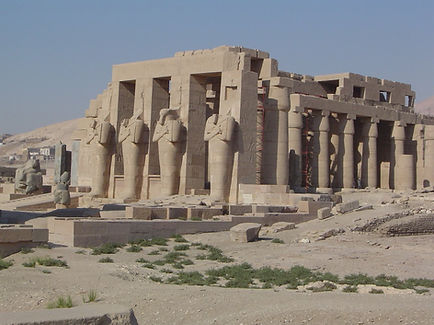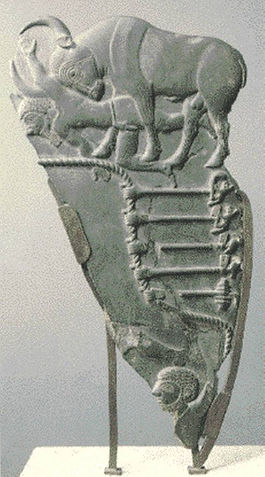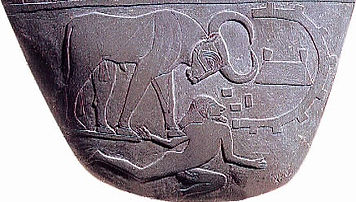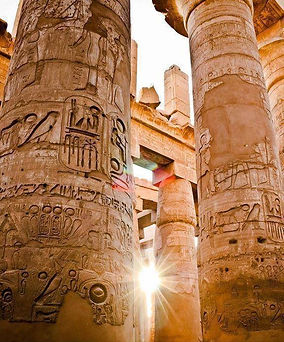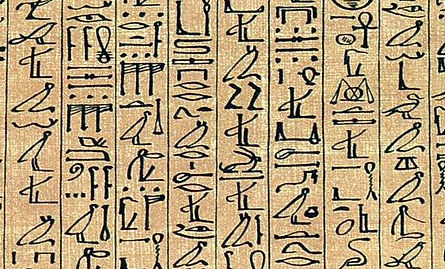



The Role of Cattle Cults and Temples in the Economy
In Ancient Egypt there were many variables that influenced or even controlled the government. One of the biggest influences was religion. Religion was a way of life, a path that guided the people on how to live. It helped the people to thrive and grow in society. Religion played a big roll with and in the economy. Two examples are the temples and Cattle Cults. The temples and cults were very influential on the everyday life and the economy; how the economy grew.
Temples were important for the ancient Egyptians. It was part of their everyday life. These temples were the key to the gods. The people were able to properly pay their respects to their gods. These temples were very sacred. “The Ancient Egyptians believed that the temples were the homes of the gods and goddesses. Every temple was dedicated to a god or goddess and he or she was worshipped there by the temple priests and pharaoh” (Anonymous, Temples, web).
Temples were also important to the government because they were wealthy. They received many gifts in different forms. “Temples too, were presented with royal gifts of land and it was not long before the nobility and the priesthood rivaled in their benefactor in wealth. The lands were hereditary and passed from father to son and eventually great parcels of crown land were distributed among the children…” (David, p.16)
These temples were also very important because they gave way to life and the economy; they were powerful. “The largest ecclesiastically-controlled economic unite in the country was the estates and workshops of the temple of Amun at Karnak. A papyrus of the reign of Ramses III says that it comprised 2393 km2 of arable land, 433 orchards, 421,362 head of livestock, 65 villages, 83 ships and 46 workshops or building sites, with a total labor force of 81,322” (Strouhal, p.232). This shows how big a temple really was. Temples were also very influential in the government. “Thanks to all manner of privileges conferred on it by the king, the economic and hence political influence on its leaders, the high priests, grew continually. They played an increasing role in government” (Strouhal, p.223). These temples were very influential during their time and they were quite powerful.
Many of the people were not allowed in the temples; instead they had to go through the priests’ to get their prayers done. “ Unlike churches, the temples were never filled with crowds of lay worshipers. Only the priests could enter the holy of holies and approach the god. By official dogma the king was the celebrant of the divine rites and high priest of all the gods; but, since he could not be in a dozen places at once, he had to delegate duties (Mertz, p.286). The common people used deities and mini statues in their altars and religious worshiping practices. They were also used during major events in a persons life. “Ivory wands inscribed with the images of demons and protective deities were routinely used in Egyptian households to create a protected zone around women in child birth, to ward off spirits that might harm the mother or baby” (Wilkinson, p.134). this was just another way to practice their religion.
Inside the temples is where the state religion is practiced. The common people or lower class had to worship the gods a little differently. The common people practiced their religion at home. “The local or household deities were worshipped in the home. Depending on locale, family, needs and preferences; the average Egyptian would choose the most suitable deities and build a household shrine for them. There were no formal cults or temples dedicated to these Gods” (anonymous, Dues and Duties, web).
The temples contributed to the economy as well. “Priests had to worship and make offerings to the Gods to keep the forces of chaos at bay. Much of these offerings came from the taxation of the working class (Sirry, Ancient Egyptian Religion - Beliefs and Rituals, web). Even temples at one point controlled the taxes of ancient Egypt. “The temples even seem to have acquired the right to levy taxes instead of the state as early as the New Kingdom, and the Thebaid became increasingly independent of the pharaonic administration centered on Lower Egypt” (anonymous, Dues and Duties, web).
The religion was very important and it was easily seen how important it was. There were many practices that displayed the importance of the religion and the people’s beliefs. “In an Egyptian temple the service went on ceaselessly from dawn to dusk to ensure that the spirit of the god content to dwell in the cult image hidden away in the interior and not abandon it…All day long the ceremony went on, a continuum of music, dance and hymns” (Stalcup, p.69).
Sometimes some temples were used to worship animals. “In some temples only a single animal would be kept like the Apis bull in the temple of Memphis…”(Stalcup,p.83-84). The bull was considered one of the most import animals. A cult that formed was the cattle cults. “… the most important of all the cults was that of the Apis bull, and this is reflected in the elaborate nature of the tombs of the bulls at Saqqara”(Stalcup, p.84).
Cattle came into play long before religion. The Ancient Egyptians used to eat the cattle to survive; they were domesticated and used for survival purposes. Cattle were also very important because they helped in the Ancient Egyptian’s everyday life. Cattle were used to plough the soil for planting. The cattle would also be used to step on the ears to separate the grain (Hirst, 2001). Cattle was used in many different rolls. They Ancient Egyptians relied on the cattle. “Domesticated, cattle were the animals the Egyptian economy was based on: cows were the main power source apart from human labour, they were milked, slaughtered, sacrificed and eaten” (Anonymous, Cattle, web).Cattle were used to farm, provide labour, and provide food and materials. Cattle were very important to the Ancient Egyptians, they helped these people to survive and live. Cattle were also used for economical purposes. They were exchanged as a form of currency. Cattle were accepted as a form of bridewealth, they were exchanged in compensation for crimes that were comminted and as a way to perpetuate ones status across many generations (Wengrow, p.93).
Soon after this we start to see the cattle being buried. We start to see cows and bulls being buried. “ …the burials of the sacred cows who were the mothers of the holy Apis bulls buried in the Serapeum” (Mertz, p.196). Cattle are becoming a sacred animal in their society. Some cattle are moved to temples where they can be worshiped. “In some temples only a single animals would be kept, like the Apis bull in the temple of Memphis, but other cults required the accommodation of large number of animals…” (Stalcup, p. 85) The cattle were so sacred that they were often inspected and counted. The cattle were very important because they would ensure one was well off in the afterlife. They would always have a source of food and labor. During ritual practices the right animal was needed. The rituals sacrifice of a bull or cow was part of a divine worship. Sometimes the priest and sometimes people who were humble would consume the meat after the sacrifice (Hirst, 2001). “Cattle with their legs tied were slaughtered by having their throats cut; with smaller animals the whole head was severed. As the blood ran out it was caught in deep bowls, sometimes tested by a physician to see if it smelled right, and immediately boiled. The animals were then skinned and the hides handed to the tanners waiting for them in the manorial tanneries. The entrails were removed, washed and set aside for early use. The limbs would be jointed with long knives and the trunk of the meat carved up, the various cuts being hung up on ropes to dry in a well-ventilated store. Sometimes the meat was cut smaller and stewed. The presence of skulls splintered at their base in the 26th-dynasty bulls’ cemetery shows that brains were also used for food” (Strouhal, p.129-30). The priest would sniff the blood of the animal to make sure it smelled right; if it smelled right the animal was pure and would be used for sacrifice.
There were many different gods that were based on cows. They were represented by a cow or bull. “ A number of gods were worshipped in the form of bulls or cows. Originally a fertility god, Apis, the most important male deity among them, took on the role of Ptah's herald and was identified with his Ka as the Splendid Soul of Ptah. After his death he merged with Osiris, and was called Serapis (Osiris-Apis), a death god. Other bull deities were Buchis (a white bull dedicated to Montu and worshiped at Hermonthis), and the Heliopolitan Mnevis (connected with Atem). Both Amen and Min carried the epithet Bull of his Mother - Kamutef. Hathor, goddess of love was depicted as a cow carrying a golden sun disk between her horns, and Isis too was closely connected with cows” (anonymous, cattle, web). The cow also symbolized rebirth, it was believed that the cow gave birth to the sun every day. They also used the cow form when a person died; when they performed the funeral rites they would place the deceased in a bed that had the shape of a cow. The cow was a symbol of rebirth: the celestial cow gave birth to the sun every day. During the funeral rites the deceased was placed on a bed which had the form of a cow Anonymous, cattle, web).
There are two different palettes that use cows in them. These palettes help to show us today what life was like, what they believed in and how they may have seen their world. The first palette is the Narmer palette. “The Narmer Palette, a shield-shaped slab of gray schist some 64 centimeters (25 inches) long, is in the shape of a cosmetic palette, a type of object made by Egyptians for at least 10 centuries before the date of the Narmer palette. What makes this particular palette of importance is that is larger than most palettes, and it is elaborately carved on both sides with images and words. In addition to the carvings illustrating Narmer's battles, the images include symbols of a cattle cult, and drawings that are typical of later Egyptian forms of decoration” (Hirst, The Narmer Palette: Early Period Ancient Egypt, web). On the Narmer Palette, the cow seen at the top of it is beleieved to be the head of the Goddess Bat. The second palette was called the Bull Palette. This palette depicts a bull standing on top of a man and trampling him to death. This palette is a mirror image, so the same image is on both the front and the back. In this palette the bull represents strength, thus representing the pharaoh (anonymous, The Bull Palette, web). This shows us how important the cattle really were. They were an important part of life, and they were important in some images because they were considered very strong by the Ancient Egyptians. They believed that the cattle were a very strong animal so they would like to be compared to a cow.
Temples and cattle were a part of these people everyday lives. The temples were very powerful and had acquired much wealth. Temples were a place of worship. It was a place where the priests and pharaoh could go to honor and receive blessings from their gods. It was a place of tranquility, although commoners were forbidden from entering, they were still able to worship their gods. Cattle were part of that religious worshiping. They were such a big part of everyday life. Cattle provided the means and tools to survive. They were also revered as being powerful in their religion. They were also worshiped immensely during this time.
Bibliography
The Bull Palette." The Bull Palette. N.p., n.d. Web. 24 Nov. 2014
http://www.reshafim.org.il/ad/egypt/bull_palette/index.html
Anonymous. "Cattle." Ancient Egyptian Bestiary:. N.p., n.d. Web. 24 Nov. 2014.
http://www.reshafim.org.il/ad/egypt/bestiary/cattle.htm
Anonymous. "Dues and Duties." In Ancient Egypt. N.p., 2000. Web. 23 Nov. 2014.
http://www.reshafim.org.il/ad/egypt/economy/taxation.htm
Anonymous. "Temples." Temples. N.p., n.d. Web. 22 Nov. 2014.
http://www.ancientegypt.co.uk/temples/home.html
David, A. Rosalie. The Egyptians Kingdoms: The Making of the Past. New York, NY: E.P. Dutton, 1975. Print.
Hirst, John. "Égypte Bovidés." Égypte Bovidés. N.p., 2001. Web. 10 Nov. 2014.
Hirst, Kris. "The Narmer Palette: Early Period Ancient Egypt." About. N.p., n.d Web. 24 Nov. 2014.
http://archaeology.about.com/od/nterms/g/narmer.htm
Mertz, Barbara. Red Land, Black Land: Daily Life in Ancient Egypt. New York: Dodd, Mead, 1978. Print.
Sirry, Mai. "Ancient Egyptian Religion - Beliefs and Rituals." Experience Ancient Egypt. N.p., Oct. 2009. Web. 23 Nov. 2014.
http://www.experience-ancient-egypt.com/ancient-egyptian-religion.html
Stalcup, Brenda. Ancient Egyptian Civilization. San Diego, CA: Greenhaven, 2000. Print.
Strouhal, Eugen. Life of the Ancient Egyptians. London: OPUS, 1989. Print.
Wengrow, David. "Rethinking ‘Cattle Cults’ in Early Egypt: Towards a Prehistoric Perspective on the Narmer Palette." Cambridge Archaeological Journal 11.01 (2001): n. pag. Web. 24 Nov. 2014. <http://www.academia.edu/6346344/Rethinking_Cattle_Cults_in_Early_Egypt_Towards_a_Prehistoric_Perspective_on_the_Narmer_Palette._Cambridge_Archaeological_Journal_2001_>.
Wilkinson, Toby A. H. The Rise and Fall of Ancient Egypt. New York: Random House, 2010. Print.

